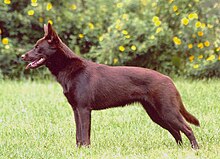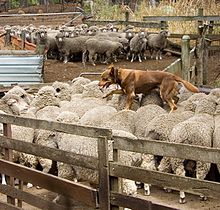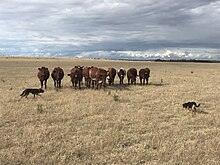Australian Kelpie
| Australian Kelpie | |||||||||||||||||||||
|---|---|---|---|---|---|---|---|---|---|---|---|---|---|---|---|---|---|---|---|---|---|
 An Australian Kelpie | |||||||||||||||||||||
| Other names | Kelpie, Barb | ||||||||||||||||||||
| Common nicknames | Farmer Dog | ||||||||||||||||||||
| Origin | Australia | ||||||||||||||||||||
| |||||||||||||||||||||
| |||||||||||||||||||||
| Dog (domestic dog) | |||||||||||||||||||||
The Australian Kelpie, or simply Kelpie, is an Australian sheepdog capable of mustering and droving with little or no guidance. It is a medium-sized dog and comes in a variety of colours. The Kelpie has been exported throughout the world and is used to muster livestock, primarily sheep, cattle and goats.
The breed has been separated into two distinct varieties: the Show (or Bench) Kelpie and the Working Kelpie.[1] The Show Kelpie is seen at conformation dog shows in some countries and is selected for appearance rather than working instinct, while the Working Kelpie is bred for its working ability.
History
[edit]

The ancestors of most Kelpies were British dogs known loosely as collies (sometimes spelled colleys). These were mostly black, or very dark brown, dogs – hence the name collie, which has the same root as coal.[2][3] (The official collie breeds were not formed until about 10 or 15 years after the Kelpie was established as a breed,[4] and the first recognised Border Collie was not brought to Australia until after the Federation in 1901).[5] Some collies were imported to Australia for stock work in the early 19th century, and were bred with other types of dogs – usually with an eye to working sheep without direct supervision.
For much of the 20th century and early 21st century it was claimed that kelpies were partly descended from dingoes.[6] In 2019, it was widely reported[7][8][9] that a genomic study conducted by researchers from the University of Sydney indicated that the kelpie had no dingo ancestry[10] although this is still uncertain. Claire Wade, co-author of the study's paper, said that she has never suggested there was "no dingo blood in the Kelpie breed" as the media reported.[11] Wade explained:
The genes studied in our analysis were specifically chosen because it is those aspects of Kelpies (the ears and the ginger/cream colours) that lead most everyday people to presume the relationship between Kelpie and dingo. The evidence of our study proves conclusively that, at least for those characteristics, there is no evidence for relationship to be found.[11]
The first dog known as a Kelpie was a black and tan female pup with floppy ears bought by Jack Gleeson about 1872[12] from a litter born on Warrock Station near Casterton, owned by George Robertson, a Scot.[13] This dog was named after the kelpie, a mythological shapeshifting water spirit of Celtic folklore.[14] In later years she was referred to as "(Gleeson's) Kelpie", to differentiate her from "(King's) Kelpie", her daughter.
The second "Kelpie" was "(King's) Kelpie", another black and tan bitch out of "Kelpie" by "Caesar", a pup from two sheepdogs imported from Scotland. "(King's) Kelpie" tied for the prestigious Forbes Trial in 1879,[15] and the strain was soon popularly referred to as "Kelpie's pups", or just Kelpies. The King brothers joined another breeder, McLeod, to form a dog breeding partnership whose dogs dominated trials during 1900 to 1920.[12]
An early Kelpie, Sally, was mated to Moss, a Smooth Collie, and she produced a black pup that was named Barb after The Barb, a black horse which had won the Melbourne Cup in 1866. Consequently, black Kelpies became known as Barb Kelpies or Barbs.[16]
There were a number of Kelpies named Red Cloud. The first and most famous was John Quinn's Red Cloud in the early 20th century. In the 1960s, another Red Cloud became well known in Western Australia. This started the tradition in Western Australia of calling all Red or Red and Tan Kelpies, especially those with white chests, Red Cloud Kelpies.[17] Other notable specimens include Gunner and Red Dog (c. 1971 – 21 November 1979), a Kelpie mix which was the subject of a movie, Red Dog, released in 2011.
Kelpies have been exported to many countries including Argentina, Canada, Italy, Korea, New Caledonia, New Zealand, Sweden, the United Kingdom and the United States for various pursuits.[16]
By 1990, Kelpies had been trained as scent dogs with good success rates. In Sweden they have been widely used for tracking and rescue work.[16]
Appearance
[edit]The Kelpie is a soft-coated, medium-sized dog, usually with prick ears and an athletic appearance. Their coat colours include black, black and tan, red, red and tan, blue, blue and tan, fawn, fawn and tan, cream, black and blue, and white and gold. The Kelpie generally weighs 14–20 kg (31–44 lb) and measures 41–51 cm (16–20 in) at the withers. They can reach a maximum weight of 25–27 kg (55–60 lb).[18]
Breed standards
[edit]Robert Kaleski published the first standard for the Kelpie in 1904. The standard was accepted by leading breeders of the time and adopted by the Kennel Club of New South Wales.[19] Contemporary breed standards vary depending on whether the registry is for working or show Kelpies. It is possible for a dog to both work and show, but options for competition in conformation shows might be limited depending on ancestry and the opinions of the kennel clubs or breed clubs involved.
In Australia, there are two separate registries for Kelpies. Working Kelpies are registered with the Working Kelpie Council (WKC)[20] and/or the Australian Sheepdog Workers Association.[21] The WKC encourages breeding for working ability, and allows a wide variety of coat colours. Show Kelpies are registered with the Australian National Kennel Council, which encourages breeding for a certain appearance and limits acceptable colours. The wide standards allowed by the WKC mean that many Working Kelpies do not meet the standard for showing.
In the US, the Kelpie is not recognised as a breed by the American Kennel Club (AKC).[22] However, the United Kennel Club and the Canadian Kennel Club recognise the Kelpie and allow them to compete in official events.[23][24] As of 2015, Australian Kelpies have been accepted by the AKC as Herding Dogs allowed to compete in AKC sanctioned Sheep Herding Trials.[25]
Working Kelpie
[edit]The Working Kelpie comes in three coat types: short, smooth and rough. The coat can be almost any colour from black to light tan or cream. Some Kelpies have a white blaze on the chest, and a few have white points. Kelpies sometimes have a double coat, which sheds out in spring in temperate climates. Agouti[26] is not unusual, and can look like a double coat.
Working Kelpies vary in size, ranging from about 19–25 in (48–64 cm) and 28–60 lb (13–27 kg).


A Working Kelpie can be a cheap and efficient worker that can save farmers and graziers the cost of several hands when mustering livestock.[27][a] The good Working Kelpies are herding dogs that will prevent stock from moving away from the stockman.[12] This natural instinct is crucial when mustering stock in isolated gorge country, where a good dog will silently move ahead of the stockman and block up the stock (usually cattle) until the rider appears.[29] Kelpies have natural instincts for managing livestock. They will work sheep, cattle, goats, pigs, poultry, and other domestic livestock. The Kelpie's signature move is to jump on the backs of sheep and walk across the tops of the sheep to reach the other side and break up the jam. Kelpies compete and are exhibited in livestock working trials, ranging from yards or arenas to large open fields working sheep, goats, cattle, or ducks.[16]
Show Kelpie
[edit]Kelpies that are bred under the ANKC registrations are registered for show (Main Register) only in the following colours: Black, Chocolate, Red, Smoky Blue, Fawn, Black and Tan, and Red and Tan. They have a double coat and pricked ears. The other colours can be registered as pets and sporting dogs (Limited Register): Blue and Tan, Fawn and Tan and Yellow/Cream. Kelpies were first exhibited in the early 20th century, at the Sydney Royal Easter Show.[16] ANKC "Show" Kelpies are now becoming very popular both nationally and internationally as family pets, companion dogs, running mates and sport dogs due to their trainability, good nature and low maintenance of care and can be found all over the world.[citation needed]
Temperament
[edit]
Show Kelpies generally excel in agility trials and may be shown in conformation in Australia.[citation needed]
Kelpies are intelligent and easy to train dogs making them good-tempered and good pets, especially with children. However they require a lot of physical exercise and mental stimulation, otherwise they can become bored and hence be disruptive by constantly barking or digging, or by chewing on objects. Working Kelpies are often described as "workaholics", with a strong drive to herd.[30]
Health
[edit]Kelpies are a hardy breed with few health problems, but they are susceptible to disorders common to all breeds, such as cryptorchidism, hip dysplasia, cerebellar abiotrophy and luxating patella. Research is underway to find the genetic marker for cerebellar abiotrophy in the breed.
A 2024 UK study found a life expectancy of 12 years based on a sample of 49 deaths for the breed compared to an average of 12.7 for purebreeds and 12 for crossbreeds.[31]
Notable Kelpies
[edit]A Kelpie owned by a Victorian dairy farmer, Maggie, was thought to be the world's oldest dog at her time of death.[32]
On the Ludo show "Bluey" one of Bluey's classmates is a red Kelpie named Rusty. Rusty is featured in the Season Three episode of Bluey called "Cricket".
Show coat colours
[edit]-
Black Kelpie
-
Chocolate Kelpie
-
Red Kelpie
-
Black and Tan Kelpie
-
Red and Tan Kelpie
-
Smoky Blue Kelpie
-
Fawn Kelpie
See also
[edit]- Australian Cattle Dog
- Australian Shepherd
- Australian Stumpy Tail Cattle Dog
- Koolie
- List of dog breeds
- Sheep husbandry
- Working Group (dogs)
Explanatory notes
[edit]References
[edit]- ^ "Australian Working Kelpie". Burke's Backyard. Retrieved 1 November 2011.
- ^ "coal". Online Etymology Dictionary – via etymonline.com.
- ^ "collie". Online Etymology Dictionary – via etymonline.com.
- ^ "beginnings". Petsburgh. 13 April 2008. Archived from the original on 13 April 2008 – via geocities.com.
- ^ "early". Petsburgh. 9 December 2007. Archived from the original on 9 December 2007 – via geocities.com.
- ^ "The mysterious origins of the Australian kelpie". abc.net.au. 9 April 2016.
- ^ "Strewth! Turns out your kelpie is not a dingo". The University of Sydney. Retrieved 14 September 2021.
- ^ "All kelpie: Study finds no dingo DNA in iconic working dog breed". www.abc.net.au. 27 June 2019. Retrieved 14 September 2021.
- ^ "Australian kelpies are not related to dingoes, but why owners wanted them to be? - Technology OrgTechnology Org". 1 June 2019. Retrieved 14 September 2021.
- ^ Chew, Tracy; Willet, Cali E.; Haase, Bianca; Wade, Claire M. (2019). "Genomic Characterization of External Morphology Traits in Kelpies Does Not Support Common Ancestry with the Australian Dingo". Genes. 10 (5): 337. doi:10.3390/genes10050337. PMC 6563003. PMID 31058880.
- ^ a b "Dingo Involvement in the Kelpie". www.wkc.org.au. Retrieved 14 September 2021.
- ^ a b c Parsons, Anthony D. (1986). The Working Kelpie. Melbourne: Nelson. ISBN 9780170067621.
- ^ "The Victor Trumpers of sheep dog trials". 1 July 2011. Retrieved 14 September 2018.
- ^ The Kelpie Foundation & John D Jack Gleeson Archived 30 December 2006 at the Wayback Machine
- ^ Historical Sheepdog Trials Archived 29 September 2006 at the Wayback Machine
- ^ a b c d e Sloane, Steve (1990). Australian Kelpie. US: TFH Publications, Inc. ISBN 9780866228664.
- ^ "Australian Kelpie". HeyDogs.com. Archived from the original on 3 June 2009. Retrieved 6 November 2009.
- ^ "Kelpie". Funk & Wagnalls New World Encyclopedia. World Almanac Education Group. 2002.
- ^ Walsh, G. P. (1983). "Kaleski, Robert Lucian (1877–1961)". Australian Dictionary of Biography. Vol. 9. National Centre of Biography, Australian National University. Retrieved 16 September 2011.
- ^ The Working Kelpie Council of Australia Archived 22 March 2004 at the Wayback Machine
- ^ "ASDWA – Australian Sheep Dog Workers' Association -". asdwa.org.au.
- ^ "Dog Breeds – Types Of Dogs". AKC.org. American Kennel Club.
- ^ "Australian Kelpie". United Kennel Club. Archived from the original on 6 February 2015. Retrieved 3 December 2014.
- ^ "CKC Breed Standards". Archived from the original on 5 October 2013.
- ^ Club, American Kennel. "Working Kelpie". akc.org.
- ^ Parmer, Ida. "Basic Coat Color Genetics". hnrworkingkelpies.com. Archived from the original on 1 December 2021. Retrieved 5 October 2017.
- ^ "Learning to train your four-legged workers". Farming Ahead. February 1997.
- ^ Sim, Terry (16 June 2021). "Hoover's $35,200 price sets world record at Casterton auction". Sheep Central. Nascon Media. Retrieved 1 January 2022.
- ^ Messner, Andrew (2006). Green Gully Historical Report. New South Wales Department of Environment and Conservation.
- ^ Wilcox, Bonnie (1989). Atlas of dog breeds of the world. Internet Archive. Neptune City, N.J. : T.F.H. Publications. ISBN 978-0-86622-899-2.
- ^ McMillan, Kirsten M.; Bielby, Jon; Williams, Carys L.; Upjohn, Melissa M.; Casey, Rachel A.; Christley, Robert M. (1 February 2024). "Longevity of companion dog breeds: those at risk from early death". Scientific Reports. 14 (1). Springer Science and Business Media LLC. doi:10.1038/s41598-023-50458-w. ISSN 2045-2322. PMC 10834484.
- ^ Hosford, Paul (20 April 2016). "The 'world's oldest dog' has died aged 30". The Journal. Retrieved 19 August 2021.
MAGGIE THE KELPIE, thought to be the world's oldest dog, has died aged 30....The former holder of the title was an Australian cattle dog named Bluey who lived to 29 and died in 1939.
Further reading
[edit]- Hartnagle-Taylor, Jeanne Joy; Taylor, Ty (2010). Stockdog Savvy. Alpine Publications. ISBN 978-1-57779-106-5.







